Namaste.
To India, then, to hunt tigers! (Photographically speaking, of
course.)
Hmm... Play this in
the background, perhaps... [Should link-rot set in, just search for
bonzo hunting tigers.]
You've all seen The Jungle Book, and we're
going to the exact area that inspired Kipling's original stories, so
you know what it's going to be like: hot and steamy!
Yeah, well what everyone knows is wrong, wrong, wrong! I will
elaborate later...

An old Chinese proverb says, "Even a journey of ten thousand miles
begins with a seafood platter and a glass or two of Chablis".
We're lucky we aren't flying from Gatwick, as alleged drone
sightings (the nature of which is still obscure as I write this
three weeks later) have caused chaos there.
We're travelling on the rather unimaginatively named Indian carrier
Jet Airways, who are supposedly better than Air India, as we
couldn't make the BA timings quite work for us. It's the first
time we've been to T4 in longer than we can remember and parts of it
are looking a bit tired now, although nothing like T3 managed to
achieve before its refurb a few years back.
1. Jamtara Lodge, Pench
It's a long flight to Delhi, then transfer to an internal flight to
Nagpur, then about four hours in a car to Jamtara Lodge near the
Pench Tiger Reserve. We get there late evening and just have a bite
to eat and go straight to bed. The five-and-a-half-hour time
difference does not cause us any problems sleeping!
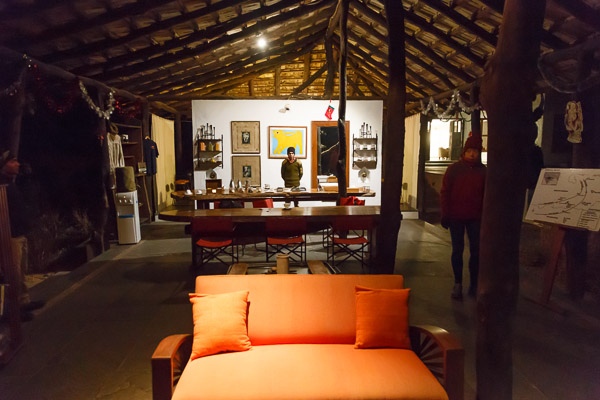
Then it's up at 5am for a morning game drive. There's coffee and
porridge in the reception area, but we'll have our proper breakfast
out in the park.
Audley's notes say that game drives can be a bit chilly, so be sure
to take long trousers and a fleece. From past experience in Africa,
we are well aware of this and prepared, but we have grossly
underestimated the conditions here. It's not just that the air is cold,
you sit in an open-top jeep and the wind chill is horrendous!
Dressed warmly, or so we thought, with blankets and hot water
bottles too, it's still bitter.
But enough with the kvetching already, let's go hunt some game!
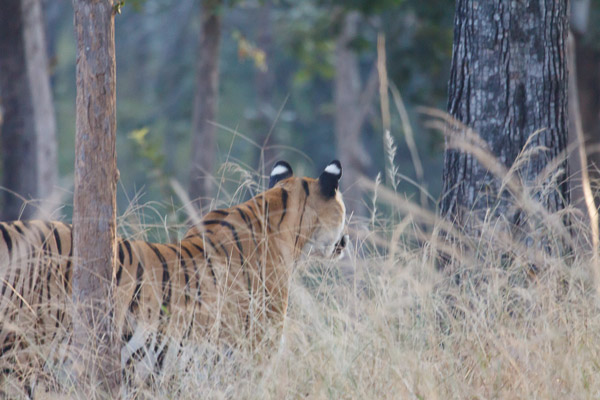
Tiger!
It's ironic, but we and several other jeeps are all at a spot where
we think there's a leopard, and everybody's trying to spot it. While
we're all looking in the wrong direction, a tiger casually comes up
behind everyone and crosses the road before continuing on into the
jungle. It's a very brief sighting, but this early in our very first
game drive, it has to be a good omen.

Birds are a bit more co-operative when it comes to posing.
Ok, you know I said we were going to the place that inspired
Kipling? We weren't surprised to see Pench describing itself as "The
Mowgli Land", but we weren't expecting this...

There are no words...
At least, none suitable for a family audience.
It has at least got warmer now, although nothing like warm enough to
strip down to just a loincloth!
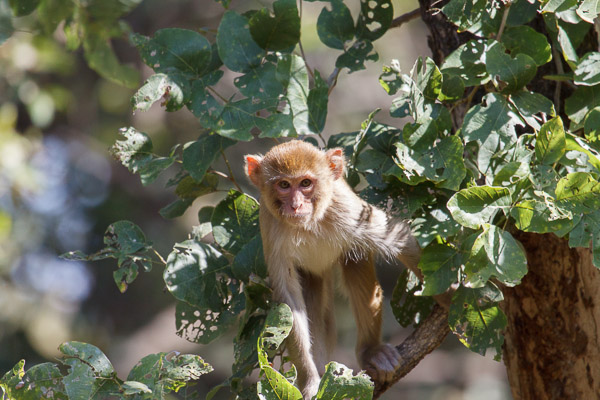
There are two main monkey species in the park. This one's a rhesus
macaque. And yes, that is rhesus as in the blood type, since
human rhesus factor was originally thought to be identical to a
similar factor found in the monkeys' blood. By the time that was
discovered not to be true, it was too late and the name has stuck.
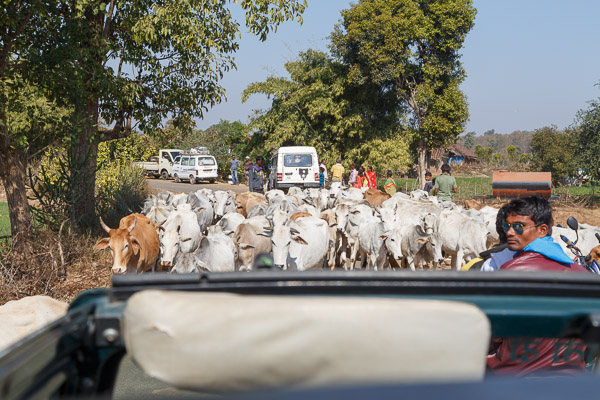
And on the way back to the lodge, that perennial problem on Indian
roads, the herd of cows.
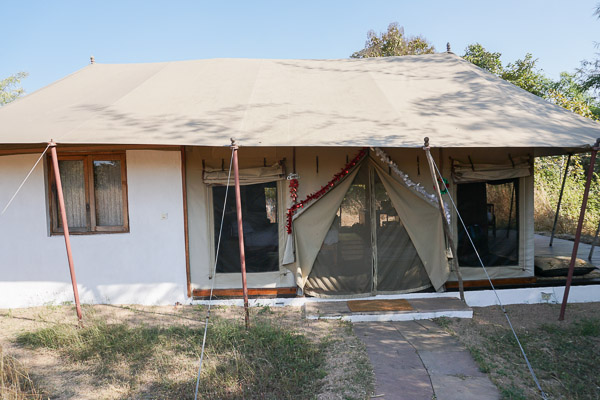
The lodge accommodation is in 'tents', but these are not exactly
your roughing-it-in-the-mud-at-Glastonbury sort. The white wall on
the left is part of the permanent en-suite bathroom around which the
tents are assembled each season.
After lunch, back to the park for the afternoon drive.

Ah, the leopard is found at last. Hard to see through the
vegetation, though.
Nothing else especially new or spectacular this afternoon. That's
not to say there wasn't much to see, but I'm trying to keep things
short. This tale will be quite long enough even so!
One rather curious observation, though. In the whole of the park, we
seem to be literally the only white folk! Everybody else we see,
without exception, is either a local worker or an Indian tourist.
Apparently one of the other gates is much closer to the city of
Nagpur than ours, and the park is very popular with families. By
contrast, when we've done African safaris, a black face that's not
part of the crew is still most likely a Western visitor! I guess the
game parks we've been to in Africa have all been well away from big
cities, but India is much more densely populated.
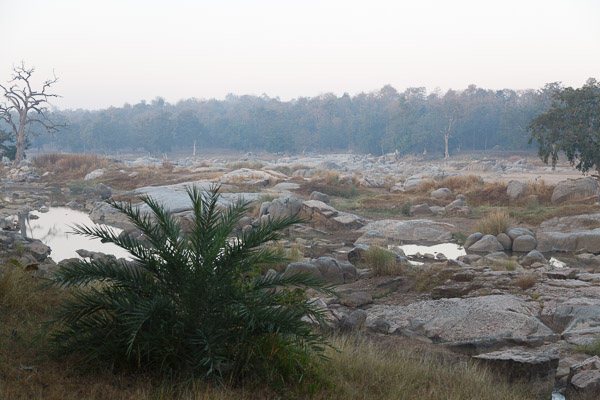
Another chilly, misty morning, but it will clear when the sun comes
up and it gets a bit warmer.
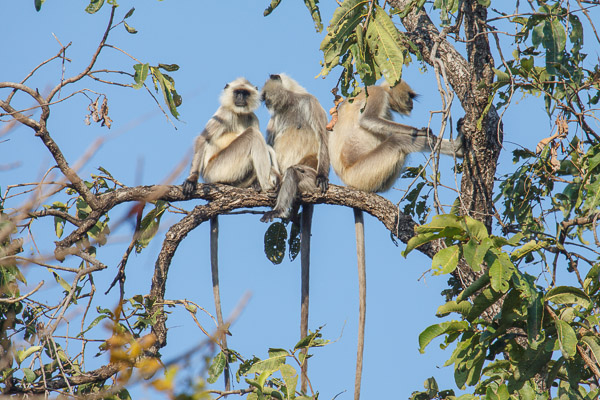
"Remind me again: am I Speak No Evil, See
No Evil or Hear No Evil?" These are the other
main local monkeys, the langurs. "Langur" comes from a Hindi word
meaning "long tail", which as you can see is pretty appropriate.

And while we're looking up at the trees, a Crested Serpent Eagle
showing off its crest. We can't see any serpents around, and judging
by its immobility, neither can it.
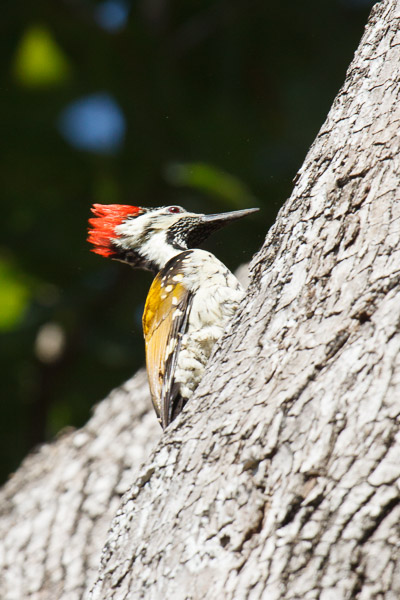
And a woodpecker, with an even more impressive crest.
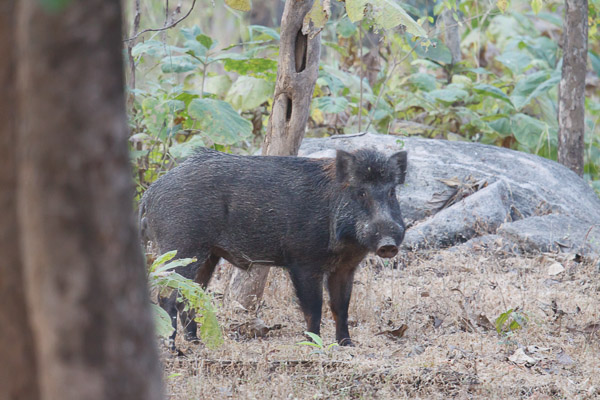
Back down at ground level, a wild pig.
No tigers at all today, let's hope yesterday wasn't just beginner's
luck!
The return to the lodge is through a village where they have a local
festival on. The big event is bullock cart racing, and we stop for a
short while to observe from the road. Our guide advises us that
while it wouldn't necessarily be dangerous to get closer, it's not
really the best idea. Drink will have been taken and bullocks can be
a bit random under the best of circumstances. Indeed at one point we
spot a runaway bullock being chased down the road by its owner and
friends!
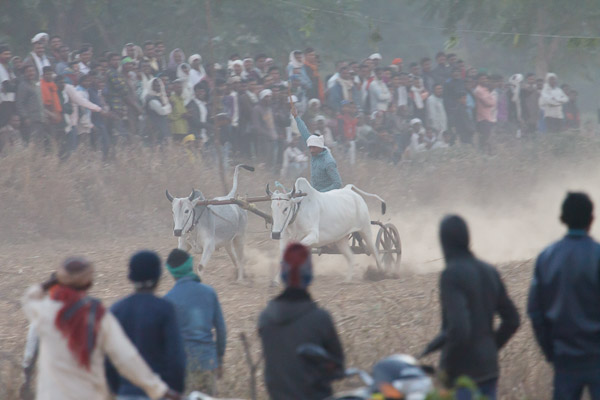
Fast and furious and very dusty!
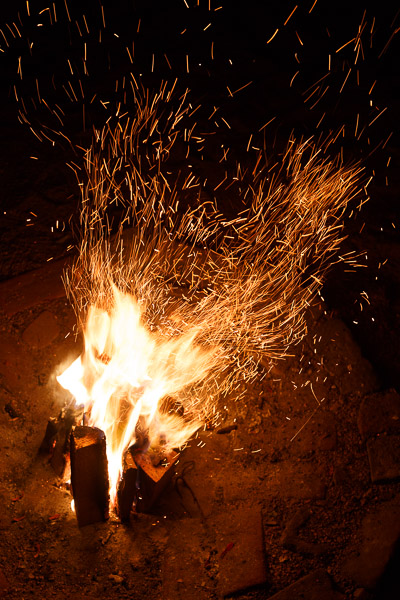
You will recall Job 5:7: "Yet man is born unto trouble, as the
sparks fly upward." This, then, is one heap of
trouble! Sounds like Job had a bit of a downer on sparks, but we
rather like them. The secret is Indian Ebony tree bark, which is
high in phosporous and makes spectacular clouds of sparks when you
put a few pieces on the fire.
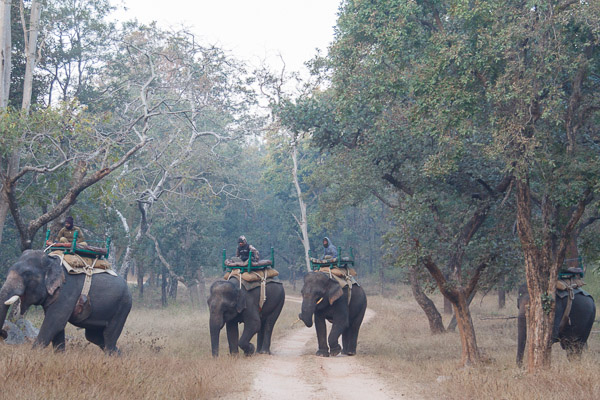
Another day, another herd of elephants.
There are no wild elephants in this or any other of the game parks
we're visiting, but the forest rangers use domesticated elephants as
patrol vehicles. Unlike some we saw on our previous trip, twenty
years ago, these all look healthy and well-cared-for.
As always, it's hard to believe anything that size can make so
little noise and disappear so thoroughly as it re-enters the forest.
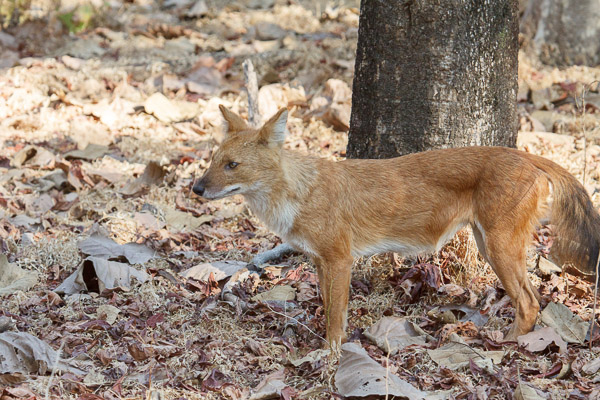
Woof! It's a wild dog. For reasons that are unclear to researchers
and park naturalists, they have suffered a steep decline in recent
years, and good sightings are no longer as common as they once were.
It's all the more surprising when we learn that they are extremely
efficient hunters in a pack, achieving something like a 90% success
rate, while tigers are the opposite, more like one success in ten.
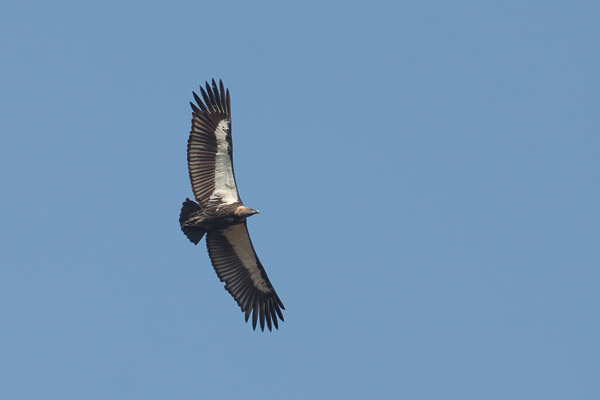
If I was properly birdish-like, I could tell you what sort of eagle
this is. I don't think it's the crested serpent eagle again,
because the picture of one of those in Wikipedia shows very
different white feather patterns.
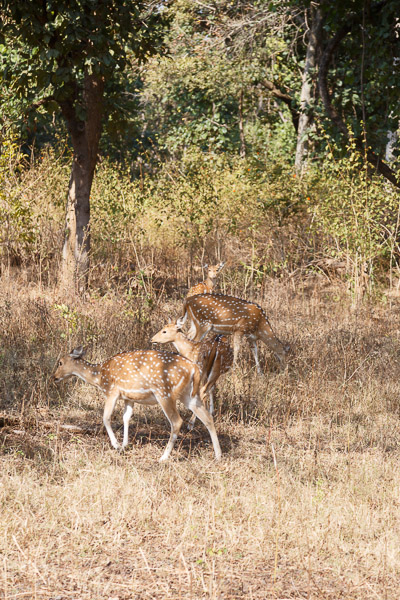
And while we're again not seeing tigers, let's take a look at tiger
food: spotted deer. Beautifully camouflaged and hard to see even
though they're just a few yards away.
We've been getting a little jeeped out, so we've asked to take a
guided walk instead of a game drive this afternoon. And hey, it's
Christmas Day, so what could be more traditional than an afternoon
walk?
We hear a tiger, but it seems he or she also hears us and
runs away. You'd think that as the apex predator, it wouldn't be
afraid of anything much, but it would appear that tigers are a lot more shy
than you might expect.
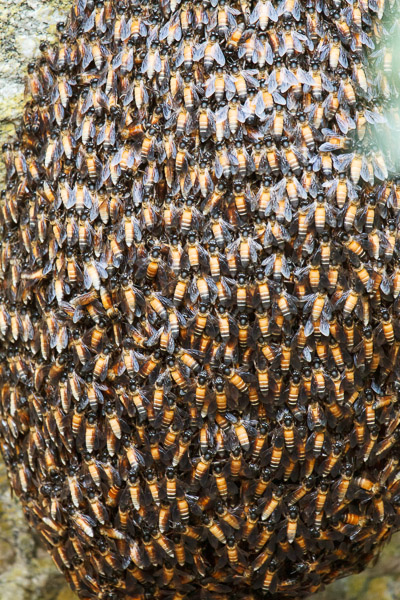
Now if you've seen the 2016 version of Disney's Jungle Book,
you'll recall that Baloo gets Mowgli to rappel down a cliff to steal
honey from rock bees. These are those very bees, except at a height
of about 1m, making them rather more accessible. Despite this, we
elect to leave the bees and any honey they might have undisturbed.
Should we meet a sloth bear, we'll just have to apologise.

How civilised. Dhiraj, our guide, prepares coffee on the river bank.
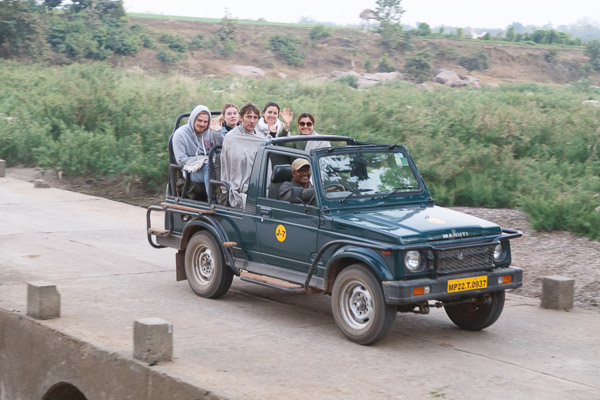
Finishing our walk, we're nice and warm in just T-shirts, when we
spot one of the jeeps with some of our fellow lodge guests, well
wrapped in blankets and still looking cold.
So to our last day in Pench.
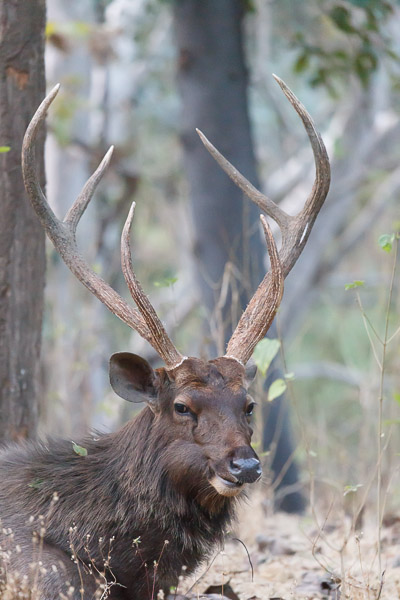
A rather fine Sambar deer.

And now we get a really good clear view of this leopard. It's Boxing
Day as it happens, and like so many back in Blighty are no doubt
doing, he's eating the Christmas Day leftovers. We spend a good
while watching him before he moves on again.

One that almost got away. The Indian Roller definitely ticks all our
bird boxes for its brilliant colours.
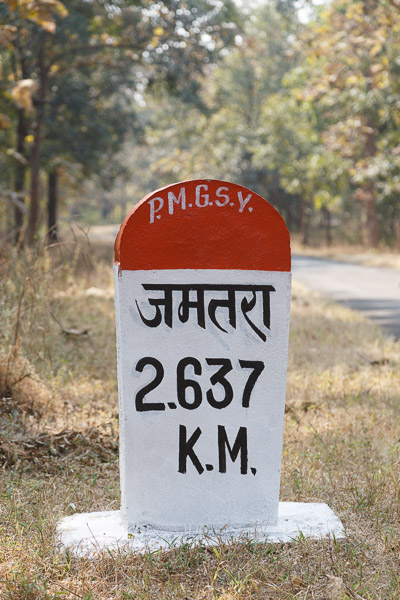
Along this road, we are offered what must be the most precise
milestones in the world. Has someone really measured the
distance to one-metre accuracy? And on the other side of the stone,
the distance is simply a whole number of km.
I am reminded of the story of the woman looking at a dinosaur
skeleton in a museum and asking the attendant how old it was.
"Eighty million and three years, madam", he replied confidently. "How
on earth do you know that?!" she cried. "Simple: they told me it was
eighty million years old when I started here, and that was three
years ago."
That's it for Pench, then. In the afternoon we drive to our next
park, Kanha.
2. Flame of the Forest Lodge, Kanha
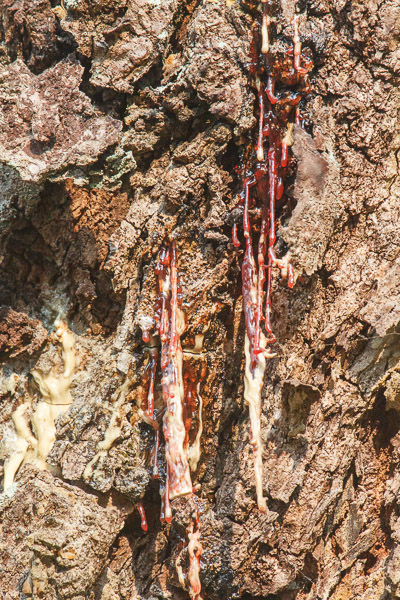
Resin stalactites on an Indian frankincense tree. I realise
we've been a bit animal-focussed so far, so here's a small gesture
to redress the anti-arboreal bias.
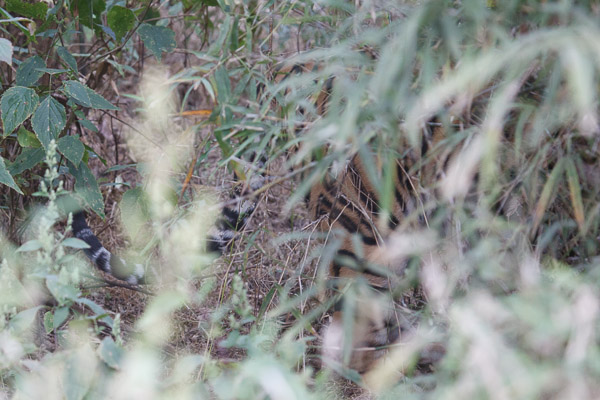
Another glimpse of tiger, but no more. It's actually better as an
experience than a still photo shows, because watching the tiger move
gives you a much clearer idea of its size and shape compared to a
snapshot that mainly serves to demonstrate how good its camouflage
is.
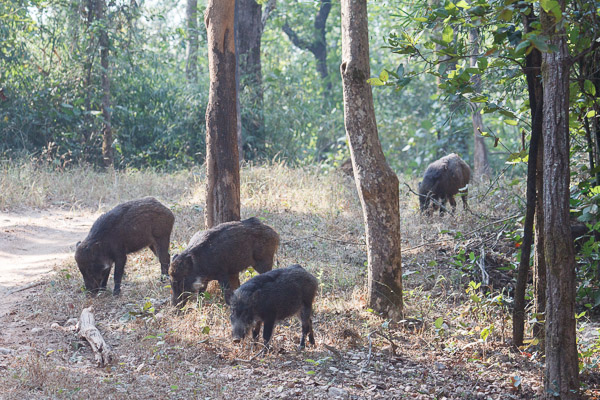
A family of wild pigs snuffling contentedly in the undergrowth. It's
a fairly safe bet there are no predators around.

On the road back to the lodge, we stop by a tree and our guide,
Mohan, points up. As is so often the case, we haven't the foggiest
notion why, and can't see a thing in the branches until suddenly the
two owls pop out at us. They make nests in holes in the trees, and
sometimes sit inside looking out; when they do that, even once
you've seen them and know what you're looking for, they blend into
near invisibility without binoculars or a long lens.
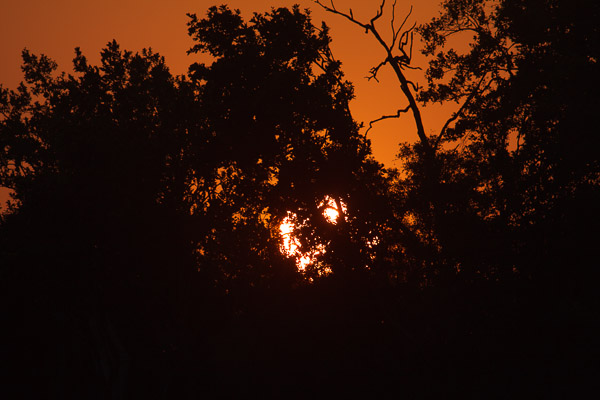
Sunset through the trees as we come to the end of our first day in
Kanha.
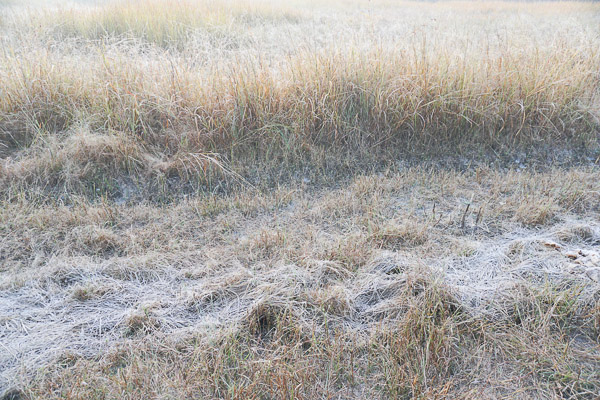
In the morning, it's not just chilly, we have a real frost. Mohan
says he's never seen it so widespread in several years at
the lodge. [As regular readers will know, this is the story of our
travel lives. We lost count years ago of the number of times we've
been told, "It's never normally like this!"]

Flying foxes. Not flying at the moment, of course, but they do
shuffle around on the branches a lot.

A rare sighting of a jungle cat. The animals themselves are not
rare, but because they're mainly nocturnal and tend to keep out of
sight, it's not common to actually see them. We've been lucky, in fact,
because we got an even better sighting at Pench, but the light was
too poor for decent photos.
[The older of my camera bodies is now
very much behind the times in terms of low-light performance. I
would probably have replaced it already except that my vision of the
perfect replacement doesn't actually match any model currently on
sale. I just thought you'd like to know that.]
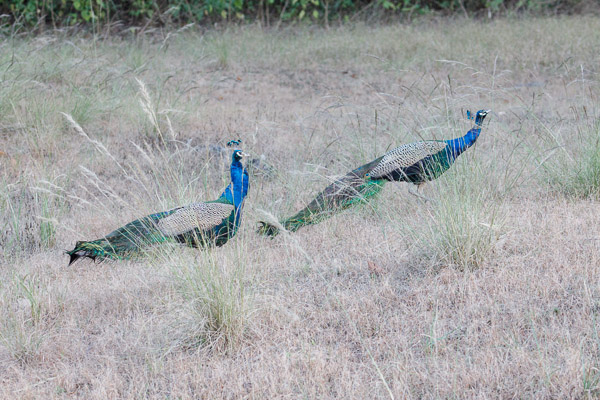
Peacocks in the wild are a slightly incongruous sight when you are
accustomed to thinking of them as ornamental birds wandering the
grounds of stately homes. They look too bright and showy to be
'wild' in any real sense, but nevertheless here they are.
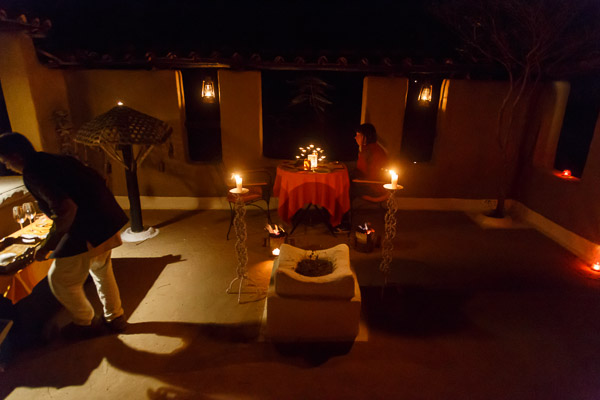
The first two nights we had a communal dinner, although since we are
the only guests right now, 'communal' meant us, Mohan, Arka (another
guide and a great photographer) and Karan, the lodge owner. Tonight,
though, we've been given personal dîner à deux in the
courtyard of our cottage.
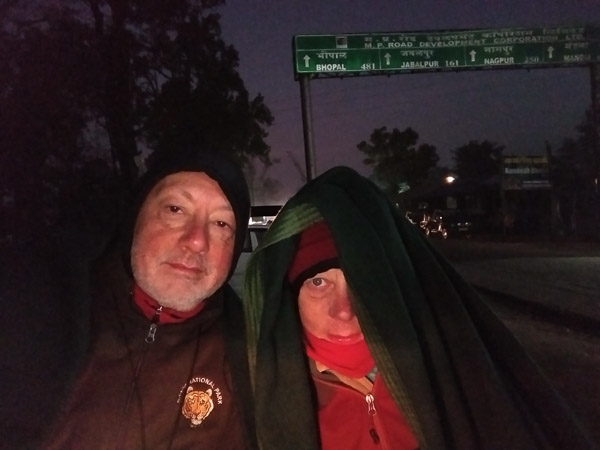
This is what we look like, before dawn, wrapped up for the game
drive. You may notice that I'm wearing a fleece jacket with a tiger
on it. This is a Kanha logo, and I bought the fleece on our first
day here when we discovered it was even colder than Pench! Amanda had
already bought one at Pench, although you can't see it in this
picture because she has another layer or two on top of it.
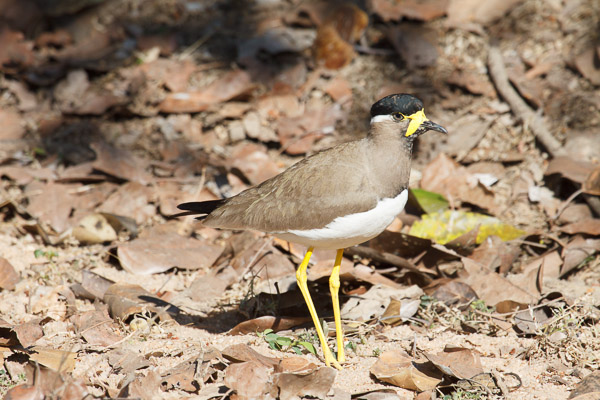
More birds: a Yellow-Wattled Lapwing.
We're a little concerned, though. Of the three parks we're visiting,
Kanha is supposed to be the best place statistically to see tigers
but we've only had one brief obscured glimpse. Pench was better but still
not great and Satpura, the remaining one, is reckoned to be the
least likely of the them all. Of course, we know perfectly well that
nothing can ever be guaranteed on a safari trip, and we have already had
some great experiences, but there's still this nagging fear of
disappointment.
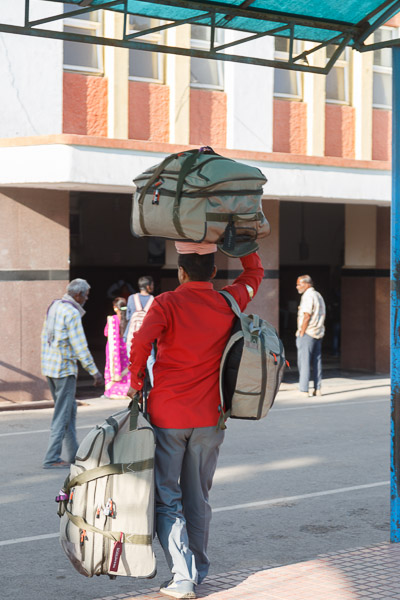
Anyway, we're taking the train to Satpura, and the services of a
porter have been engaged on our behalf. Can't quite see that
happening at Waterloo.
3. Reni Pani Jungle Lodge, Satpura
This is going to be a bit different. For the first two days, we're
going to be walking and camping out. Well, I say 'we' are going to
be camping, but in truth, all we will have to do is turn up and
enjoy the camp that the crew has set up for us.

We set out. Amanda on the left, Sid (short for Siddharth), our
naturalist guide in the middle, and Sanjay, the local guide on the
right.

This is the kind of country we're trekking through on day one. It's
pretty hilly and there are lots of ups and downs, but it's beautiful
and peaceful and makes a fine change from the frenetic chasing
around in jeeps we've mostly been doing.
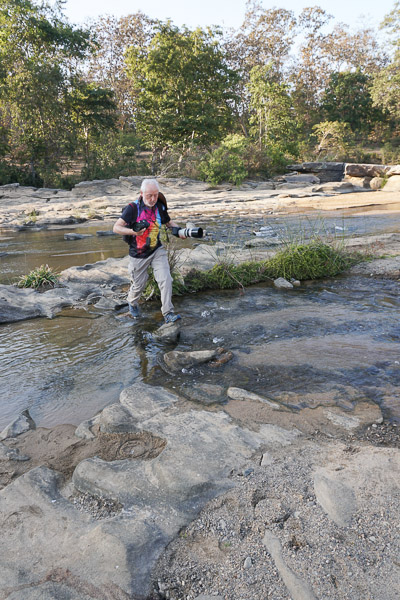
There are rivers to cross, but as it's winter and the dry season,
it's easy enough to hop from rock to rock if you like that kind of
thing. Which I do.
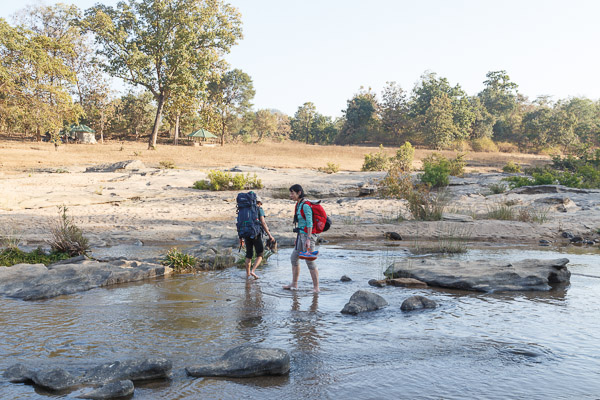
Amanda and Sid, conversely, prefer to wade across. Behind them, you
can see the first night's camp.
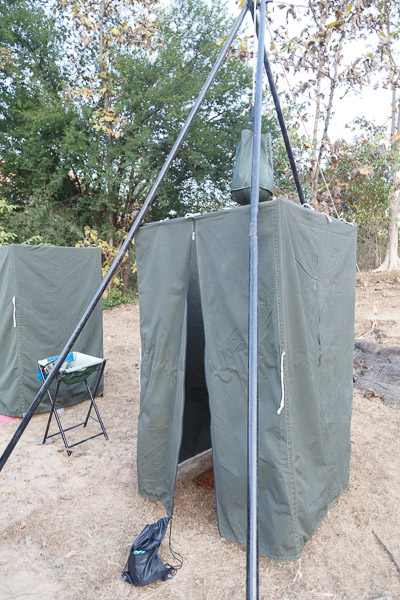
The shower isn't quite en-suite, but it would be churlish to
complain!
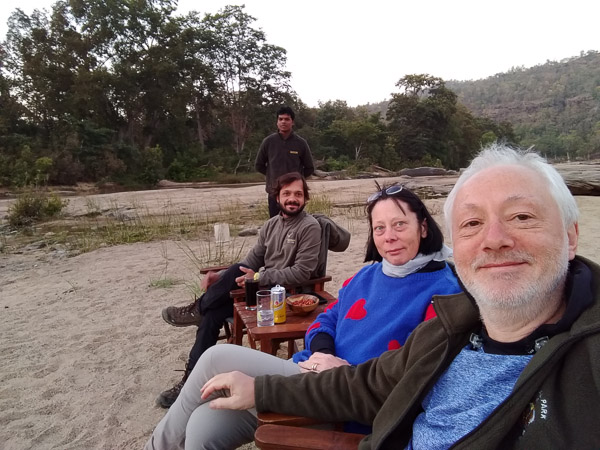
Some drinks and nibbles before dinner. At the back is Jitendar,
who's pretty much our butler. There are two more guys behind the
scenes making up the crew.
Dinner by the fire, and so to bed.
The next day's walk is primarily along the river. It's flatter,
true, but the sand would do any beach resort proud and it's harder
to make progress than you might expect.
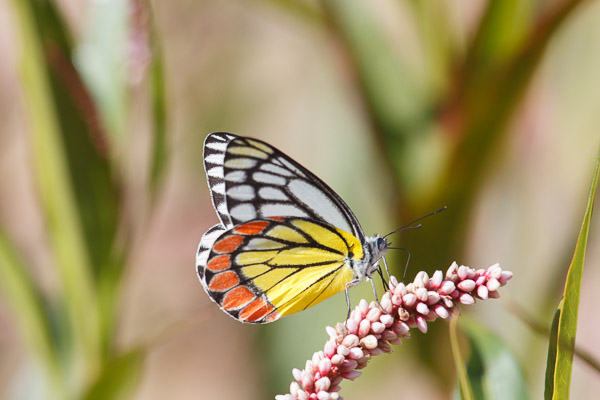
Invertebrate time. Yes, there were butterflies to be seen
previously, but not that you could really see. This is a
Common Jezebel, and apparently it is indeed common across South and
Southeast Asia. But it certainly isn't common in Surrey!
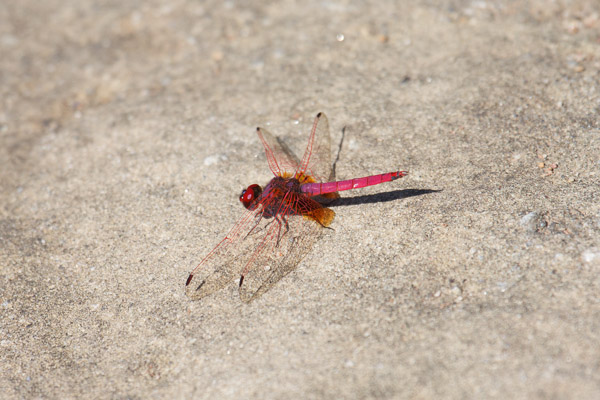
This beautiful pinky-red dragonfly is probably not so different from
the ones we get in our garden, though I don't recall seeing that
exact colour before.
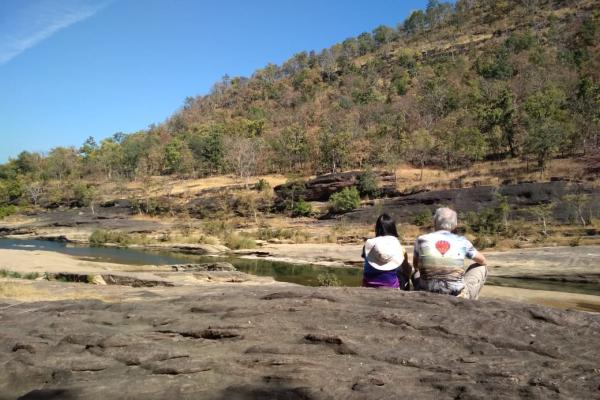
After lunch, we just sit and enjoy the scenery for a little.
(Picture courtesy Sid, thanks.)
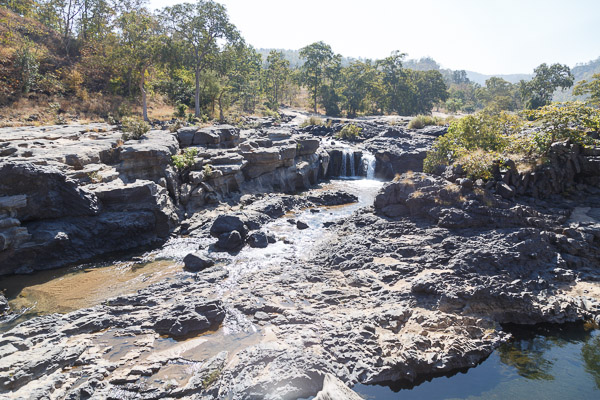
In monsoon season, this is all completely underwater, and even
outside the wettest times it's more the exception than the rule to
be able to cross without getting your feet wet.
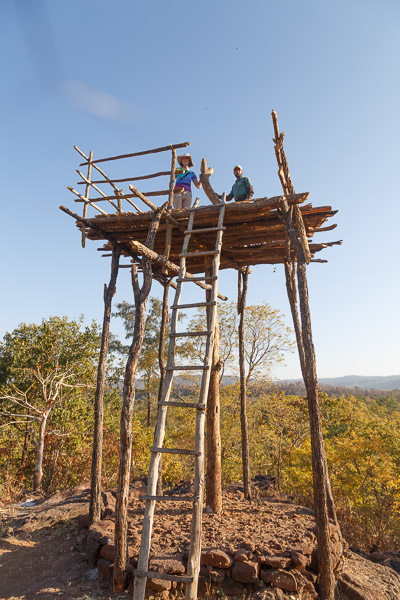
This rickety-looking structure is indeed rickety, and Amanda
standing on the top is not something anyone who knows her would be
naturally inclined to believe without proof! It's a fire watch tower
with superb views in all directions and certainly worth the climb,
and Amanda says that she just had to do it without any time for
thinking about it or she'd have lost her nerve.
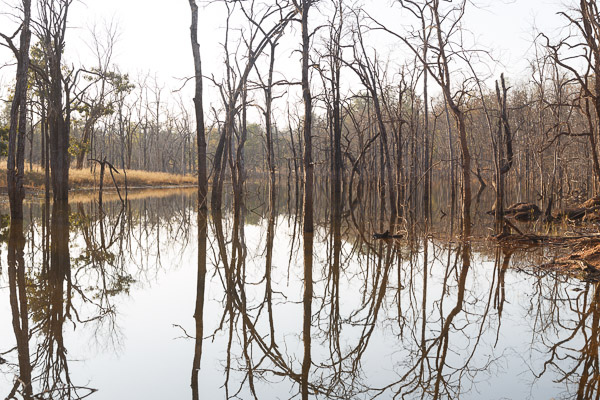
Dams have created artificial ponds and small lakes.

And talking of things we do and don't have in Surrey, some
parakeets.
Today's distance is about 16km compared to yesterday's 12km, and
with all the stopping to see things, we find ourselves potentially
running a bit short of daylight. Suddenly the pace picks up until
we're back in virtual sight of camp. As before, the boys have set
everything up for us, so all we have to do is take a shower, change
our clothes and enjoy some fine food and drink.
It's a tough life, this safari business.
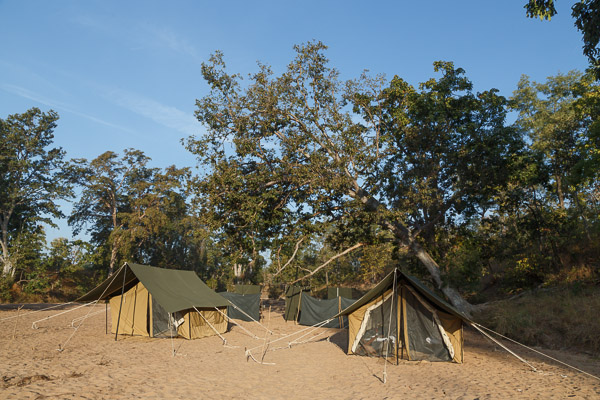
So it's goodbye to our camp.
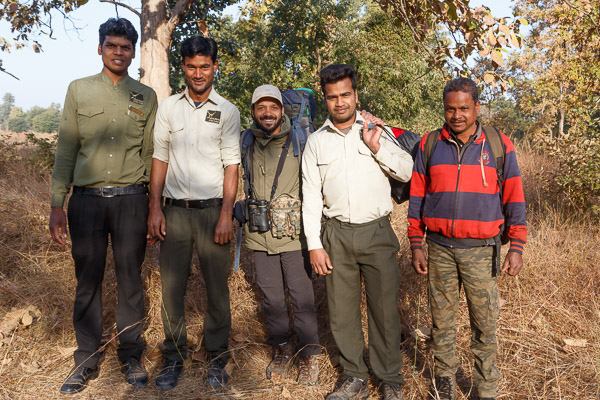
And goodbye to the team.
Well, not really, because all but Sanjay will be coming back to Reni
Pani with us, but they've done us proud and it's nice to have a
picture of them all together.

Perhaps strangely, we've not seen many lizards or other reptiles at
all. This one is sitting on a lantern that illuminates a section of
lodge path.
Tomorrow we're back doing jeeps, although we can start off in a
closed car, not sitting up in the icy blast if we want. Do we want?
YES PLEASE!!!
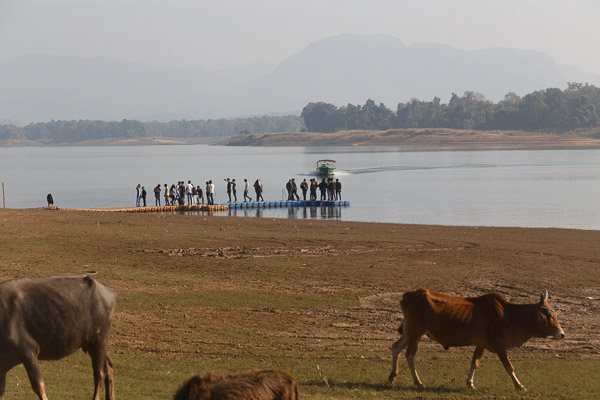
This is why we don't have to start in the jeep. Access to the park
is by boat, and the jeeps are all on the other side of the river.

Well here's something new, a Sloth Bear! It's called "bhālu"
in Hindi, hence Baloo in The Jungle Book. We spend quite a
while watching him shuffle around in the forest, barely visible much
of the time, but Sid has a feeling that he's eventually going to
come out right where we're waiting, and indeed he does.

Yay! Proper tiger!
Well there we are: in the park least rated for tiger sightings, we
finally get what we'd hoped for.

She walks right by the jeeps, then past them and strolls down the
road. She's heading towards an area we're not allowed to drive in,
but nobody seems to want to chase her anyway. This is her forest and
it wouldn't be right to harass her in it.
And it's New Year's Day today, which means we can legitimately use
this picture for the January page of next year's calendar!
Result!
Ok, so in a sense this is what we came for, but it would be quite
wrong to suggest that the rest is an anti-climax now. It's more
like: ok, we no longer have to worry that we'll feel we've spent all
this money for nothing, and then feel guilty because it's certainly
not nothing, so we can just relax and enjoy whatever happens or
doesn't happen now.
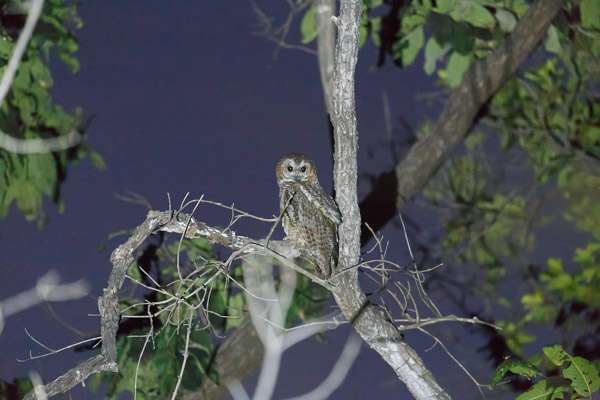
One thing we've not been able to do in India which we've done in other places
is a night safari. But on the way back to the lodge, Sid shines his
torch on another owl in a tree so we have just a little nocturnal
adventure.

"How doth the little crocodile improve his shining tail?"
Not sure how dangerous he would be, but he's on the other side of
the river and our side doesn't have any gently sloping
crocodile-friendly banks.

And another one we've just had snatches of before now, the giant
tree squirrel.
Well, without a doubt, Pench and Kanha were great, but Satpura
really has to take the overall prize. Not just for the animals, but
the camping trek was fabulous and it's something that can't be done
in any of the other parks.
But this is the end of the safari, although not quite the end of our
holiday. We have two nights and a full day in Bhopal because of the
flight timings, and although we're not mad keen on Indian cities,
we've been told it's worth a look.
4. Jehan Numa Retreat, Bhopal
It's supposedly one of the cleanest and greenest cities in India,
although even the locals admit that that's not setting a very high
bar.
The hotel we're staying at is part of the same group as Reni Pani,
and while it's very different, it sets the same high standard. Our itinerary
has us out essentially the whole day from tomorrow morning, but we
want the afternoon to relax before our flight, so we cancel the
planned excursion to the temples of Sanchi. Doubtless very interesting
but just too much for us now.
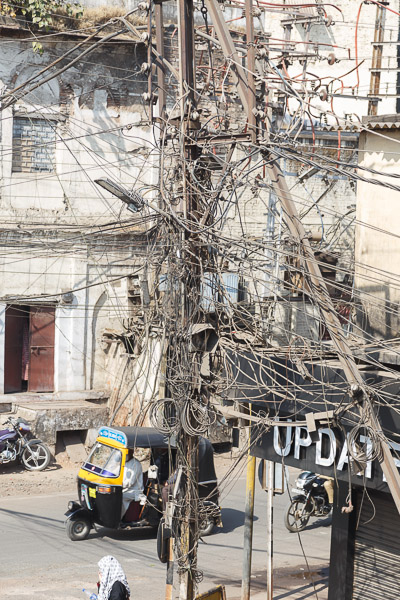
Ah, Third World cabling, although this is pretty chaotic even by
Asian standards. We're looking out from a cloister of the biggest
mosque in India, although it's not the largest mosque in
India. Confused? Well apparently the biggest mosque is the
one with the biggest actual building, while the largest
mosque is the one covering the largest total area.
This is the kind of sleight-of-language that would make any
politician proud!
If the only thing we Brits gave to India was the linguistic and
cultural toolkit to create such gloriously creative obfuscations,
then I think we can hold our heads high.

A spin around the city museum: Lord Ganesha looks like he knows how
to party!
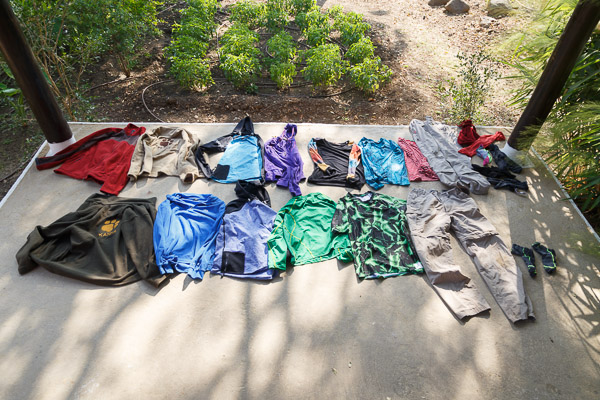
Preparing our final packing for the flight home, just for
curiosity's sake, we lay out a couple of typical Kanha game drive
outfits! Amanda's is the top row, mine the bottom. Even with
all those layers plus hot water bottles and blankets,
overheating was never a risk!
We have a splendid dinner at the hotel, a little surprise gift from
Audley. We've been pretty good customers of theirs over
the years and I think this is by way of a small thank-you. We have a private
table under a tree and the chef comes out to explain each dish to
us in turn. They're all based on local ingredients (many grown in the
hotel's own garden) and traditional styles, under the umbrella title
of "Lost Recipes of Central India". This is not your average curry.
Educational and delicious and much appreciated!
Now for an early morning and the long trip home.
There's still loads I haven't written about or illustrated, but I
have to stop somewhere and this is where.
Namaste.
Steve.